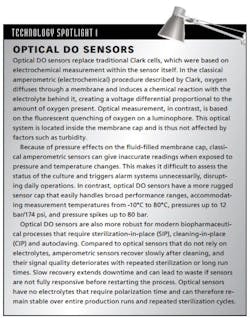FOLLOW-THROUGH
“It is hard to get new sensors into manufacturing at a large pharmaceutical company,” says Larson. “You need a lot of data to make the case that the new sensor will be beneficial.”
“We test new sensor technology in our pilot plants,” she explains. “Once we have experience with it, and it proves robust and solves the problem that we are trying to solve, then we send the data to manufacturing operations for deployment consideration.” For sensor design engineers wondering how to get started with PAT, Larson advises a “sensible” approach. “The technologist designing a sensor must understand the manufacturing problem.”
Once the decision is made, the deployment itself requires careful attention to ensure proper setup and configuration. Thoroughly planning implementation ensures that the benefits of the new sensor technology are realized, while helping to minimize organizational and validation-related questions. Training, data collection, data analysis, integration into third-party equipment, version management and reporting are just a few of the considerations that require careful planning before implementation begins. Another important question to answer is how data acquisition technology will be used to maintain control of all the new data.
With the goal of any process improvement being to initiate a new approach, it is important to have support, both internally and externally. Partnerships with sensor vendors extend beyond ensuring successful deployment. “Pharmaceutical manufacturers get involved in sensor design by surveying the landscape for new sensor technology and disposables and partnering with vendors in two basic situations: when they see a technology that they think is worth developing, and when a vendor is close to bringing to market a new technology that is of interest to the company,” says Larson.
Regardless of the type of innovation being introduced, successful deployment of bioprocess sensors requires that implementation of a new technology follow PAT guidelines, be suited for the manufacturing process, answer the question it is meant to address, and add enough value to justify making a change. The right choice varies with the situation; different products require different controls and possibly different sensors, and the cost-benefit ratio depends on the size and age of the manufacturing plant. Adoption of new technology often results in unexpected improvements in process understanding and performance.
Acknowledgements
The authors would like to thank the following industry experts:
Tina Larson is a bioprocess engineer who has spent her career in biochemical manufacturing operations for major pharmaceutical corporations. In her current role, she is the head of technical development operations and engineering for a large biopharmaceutical manufacturing organization.
L. Harry Lam, Ph.D., is a bioprocess engineer who has spent his career in biochemical manufacturing operations for major pharmaceutical corporations, where he has been responsible for technology implementation and many successful development projects and manufacturing campaigns. Lindsay Leveen, currently a consultant, is a manufacturing process industry strategist and early technology adopter focused on sustainable development. He led manufacturing technology implementation for biopharmaceuticals, where he was an early proponent of single-use methods.
References
1. Tillich D. Hamilton Visiferm. DO Sensors: Optical Oxygen Measurement with Builtin Electronics in a 120mm Format. CHEManagerEurope May 2007:25.
2. Hamilton Company. October 7 2009. HAMILTON Unveils ARC Sensor Technology.
3. Bakeev, Katherine A. 2010. Process Analytical Technology: Spectroscopic Tools and Implementation Second Edition. John Wiley & Sons. 576p.
4. WAVE Biotech
5. Eibl, R, Eibl, D. 2011. Single Use Technology in Biomanufacturing John Wiley & Sons. 360p.






